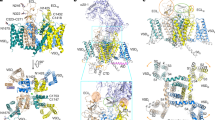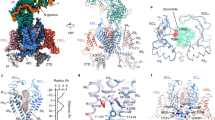Abstract
Changes in activity-dependent calcium flux through voltage-gated calcium channels (CaVs) drive two self-regulatory calcium-dependent feedback processes that require interaction between Ca2+/calmodulin (Ca2+/CaM) and a CaV channel consensus isoleucine-glutamine (IQ) motif: calcium-dependent inactivation (CDI) and calcium-dependent facilitation (CDF). Here, we report the high-resolution structure of the Ca2+/CaM–CaV1.2 IQ domain complex. The IQ domain engages hydrophobic pockets in the N-terminal and C-terminal Ca2+/CaM lobes through sets of conserved 'aromatic anchors.' Ca2+/N lobe adopts two conformations that suggest inherent conformational plasticity at the Ca2+/N lobe–IQ domain interface. Titration calorimetry experiments reveal competition between the lobes for IQ domain sites. Electrophysiological examination of Ca2+/N lobe aromatic anchors uncovers their role in CaV1.2 CDF. Together, our data suggest that CaV subtype differences in CDI and CDF are tuned by changes in IQ domain anchoring positions and establish a framework for understanding CaM lobe–specific regulation of CaVs.
This is a preview of subscription content, access via your institution
Access options
Subscribe to this journal
Receive 12 print issues and online access
$189.00 per year
only $15.75 per issue
Buy this article
- Purchase on Springer Link
- Instant access to full article PDF
Prices may be subject to local taxes which are calculated during checkout





Similar content being viewed by others
Accession codes
References
Hille, B. Ion Channels of Excitable Membranes (Sinauer Associates, Inc., Sunderland, Massachusetts, USA, 2001).
Catterall, W.A. Structure and regulation of voltage-gated Ca2+ channels. Annu. Rev. Cell Dev. Biol. 16, 521–555 (2000).
Saimi, Y. & Kung, C. Calmodulin as an ion channel subunit. Annu. Rev. Physiol. 64, 289–311 (2002).
Kang, M.G. & Campbell, K.P. Gamma subunit of voltage-activated calcium channels. J. Biol. Chem. 278, 21315–21318 (2003).
Sheng, Z.H., Westenbroek, R.E. & Catterall, W.A. Physical link and functional coupling of presynaptic calcium channels and the synaptic vesicle docking/fusion machinery. J. Bioenerg. Biomembr. 30, 335–345 (1998).
Walker, D. & De Waard, M. Subunit interaction sites in voltage-dependent Ca2+ channels: role in channel function. Trends Neurosci. 21, 148–154 (1998).
Kandel, E.R., Schwartz, J.H. & Jessell, T.M. Principles of Neural Science (McGraw-Hill, New York, USA, 2000).
Budde, T., Meuth, S. & Pape, H.C. Calcium-dependent inactivation of neuronal calcium channels. Nat. Rev. Neurosci. 3, 873–883 (2002).
DeMaria, C.D., Soong, T.W., Alseikhan, B.A., Alvania, R.S. & Yue, D.T. Calmodulin bifurcates the local Ca2+ signal that modulates P/Q-type Ca2+ channels. Nature 411, 484–489 (2001).
Lee, A. et al. Ca2+/calmodulin binds to and modulates P/Q-type calcium channels. Nature 399, 155–159 (1999).
Lee, A., Zhou, H., Scheuer, T. & Catterall, W.A. Molecular determinants of Ca2+/calmodulin-dependent regulation of Cav2.1 channels. Proc. Natl. Acad. Sci. USA 100, 16059–16064 (2003).
Peterson, B.Z., DeMaria, C.D., Adelman, J.P. & Yue, D.T. Calmodulin is the Ca2+ sensor for Ca2+-dependent inactivation of L-type calcium channels. Neuron 22, 549–558 (1999).
Qin, N., Olcese, R., Bransby, M., Lin, T. & Birnbaumer, L. Ca2+-induced inhibition of the cardiac Ca2+ channel depends on calmodulin. Proc. Natl. Acad. Sci. USA 96, 2435–2438 (1999).
Zühlke, R.D., Pitt, G.S., Deisseroth, K., Tsien, R.W. & Reuter, H. Calmodulin supports both inactivation and facilitation of L-type calcium channels. Nature 399, 159–162 (1999).
Zühlke, R.D., Pitt, G.S., Tsien, R.W. & Reuter, H. Ca2+-sensitive inactivation and facilitation of L-type Ca2+ channels both depend on specific amino acid residues in a consensus calmodulin-binding motif in the (alpha)1C subunit. J. Biol. Chem. 275, 21121–21129 (2000).
Alseikhan, B.A., DeMaria, C.D., Colecraft, H.M. & Yue, D.T. Engineered calmodulins reveal the unexpected eminence of Ca2+ channel inactivation in controlling heart excitation. Proc. Natl. Acad. Sci. USA 99, 17185–17190 (2002).
Pitt, G.S. et al. Molecular basis of calmodulin tethering and Ca2+-dependent inactivation of L-type Ca2+ channels. J. Biol. Chem. 276, 30794–30802 (2001).
Erickson, M.G., Liang, H., Mori, M.X. & Yue, D.T. FRET two-hybrid mapping reveals function and location of L-type Ca2+ channel CaM preassociation. Neuron 39, 97–107 (2003).
Romanin, C. et al. Ca(2+) sensors of L-type Ca(2+) channel. FEBS Lett. 487, 301–306 (2000).
Tang, W. et al. Apocalmodulin and Ca2+ calmodulin-binding sites on the CaV1.2 channel. Biophys. J. 85, 1538–1547 (2003).
Pate, P. et al. Determinants for calmodulin binding on voltage-dependent Ca2+ channels. J. Biol. Chem. 275, 39786–39792 (2000).
Black, D.J. et al. Calmodulin interactions with IQ peptides from voltage-dependent calcium channels. Am. J. Physiol. Cell Physiol. 288, C669–C676 (2005).
Liang, H. et al. Unified mechanisms of Ca(2+) regulation across the Ca(2+) channel family. Neuron 39, 951–960 (2003).
Osawa, M. et al. A novel target recognition revealed by calmodulin in complex with Ca2+-calmodulin-dependent kinase kinase. Nat. Struct. Biol. 6, 819–824 (1999).
Kurokawa, H. et al. Target-induced conformational adaptation of calmodulin revealed by the crystal structure of a complex with nematode Ca(2+)/calmodulin-dependent kinase kinase peptide. J. Mol. Biol. 312, 59–68 (2001).
Bahler, M. & Rhoads, A. Calmodulin signaling via the IQ motif. FEBS Lett. 513, 107–113 (2002).
Jurado, L.A., Chockalingam, P.S. & Jarrett, H.W. Apocalmodulin. Physiol. Rev. 79, 661–682 (1999).
Dunitz, J.D. Win some, lose some: enthalpy-entropy compensation in weak intermolecular interactions. Chem. Biol. 2, 709–712 (1995).
Gao, T., Bunemann, M., Gerhardstein, B.L., Ma, H. & Hosey, M.M. Role of the C terminus of the alpha 1C (CaV1.2) subunit in membrane targeting of cardiac L-type calcium channels. J. Biol. Chem. 275, 25436–25444 (2000).
Lee, A., Scheuer, T. & Catterall, W.A. Ca2+/calmodulin-dependent facilitation and inactivation of P/Q-type Ca2+ channels. J. Neurosci. 20, 6830–6838 (2000).
Zühlke, R.D. & Reuter, H. Ca2+-sensitive inactivation of L-type Ca2+ channels depends on multiple cytoplasmic amino acid sequences of the alpha1C subunit. Proc. Natl. Acad. Sci. USA 95, 3287–3294 (1998).
Kim, J., Ghosh, S., Nunziato, D.A. & Pitt, G.S. Identification of the components controlling inactivation of voltage-gated Ca2+ channels. Neuron 41, 745–754 (2004).
Deschenes, I. et al. Isoform-specific modulation of voltage-gated Na(+) channels by calmodulin. Circ. Res. 90, E49–E57 (2002).
Kim, J. et al. Calmodulin mediates Ca2+ sensitivity of sodium channels. J. Biol. Chem. 279, 45004–45012 (2004).
Mori, M. et al. Novel interaction of the voltage-dependent sodium channel (VDSC) with calmodulin: does VDSC acquire calmodulin-mediated Ca2+-sensitivity? Biochemistry 39, 1316–1323 (2000).
Clackson, T. & Wells, J.A. A hot spot of binding energy in a hormone-receptor interface. Science 267, 383–386 (1995).
Leavitt, S. & Freire, E. Direct measurement of protein binding energetics by isothermal titration calorimetry. Curr. Opin. Struct. Biol. 11, 560–566 (2001).
Jencks, W.P. On the attribution of additivity of binding energies. Proc. Natl. Acad. Sci. USA 78, 4046–4050 (1981).
Mouton, J., Feltz, A. & Maulet, Y. Interactions of calmodulin with two peptides derived from the c-terminal cytoplasmic domain of the Ca(v)1.2 Ca2+ channel provide evidence for a molecular switch involved in Ca2+-induced inactivation. J. Biol. Chem. 276, 22359–22367 (2001).
Xiong, L., Kleerekoper, Q.K., He, R., Putkey, J.A. & Hamilton, S.L. Sites on calmodulin that interact with the C-terminal tail of Cav1.2 channel. J. Biol. Chem. 280, 7070–7079 (2005).
Hoeflich, K.P. & Ikura, M. Calmodulin in action: diversity in target recognition and activation mechanisms. Cell 108, 739–742 (2002).
Van Petegem, F., Clark, K.A., Chatelain, F.C. & Minor, D.L., Jr . Structure of a complex between a voltage-gated calcium channel beta-subunit and an alpha-subunit domain. Nature 429, 671–675 (2004).
Kholod, N. & Mustelin, T. Novel vectors for co-expression of two proteins in E. coli. Biotechniques 31, 322–323 326–328 (2001).
Kapust, R.B. et al. Tobacco etch virus protease: mechanism of autolysis and rational design of stable mutants with wild-type catalytic proficiency. Protein Eng. 14, 993–1000 (2001).
Van Duyne, G.D., Standaert, R.F., Karplus, P.A., Schreiber, S.L. & Clardy, J. Atomic structures of the human immunophilin FKBP-12 complexes with FK506 and rapamycin. J. Mol. Biol. 229, 105–124 (1993).
McPherson, A. Crystallization of Biological Macromolecules (Cold Spring Harbor Press, Cold Spring Harbor, New York, USA, 1999).
Otwinowski, Z. & Minor, W. Processing of X-ray diffraction data collected in oscillation mode. Methods Enzymol. 276, 307–326 (1997).
Schneider, T.R. & Sheldrick, G.M. Substructure solution with SHELXD. Acta Crystallogr. D Biol. Crystallogr. 58, 1772–1779 (2002).
d Fortelle, E.l. & Bricogne, G. Maximum-likelihood heavy atom parameter refinement for multiple isomorphous replacement and multiwavelength anomalous diffraction methods. Methods Enzymol. 276, 472–494 (1997).
Terwilliger, T.C. Maximum-likelihood density modification. Acta Crystallogr. D Biol. Crystallogr. 56, 965–972 (2000).
Perrakis, A., Morris, R. & Lamzin, V.S. Automated protein model building combined with iterative structure refinement. Nat. Struct. Biol. 6, 458–463 (1999).
McRee, D.E. XtalView/Xfit–A versatile program for manipulating atomic coordinates and electron density. J. Struct. Biol. 125, 156–165 (1999).
Collaborative Computational Project, Number 4. The CCP4 suite: Programs for protein crystallography. Acta Crystallogr. D Biol. Crystallogr. 50, 760–763 (1994).
Edelhoch, H. Spectroscopic determination of tryptophan and tyrosine in proteins. Biochemistry 6, 1948–1954 (1967).
Acknowledgements
We thank K. Brejc and D. Fass for comments on the manuscript; J. Holton at Beamline 8.3.1 at the Advanced Light Source for help with data collection; C.B. Klee (US National Institutes of Health, Bethesda, Maryland, USA) for the calmodulin clone; R.W. Tsien (Stanford University School of Medicine, Stanford, California, USA) and D.T. Yue (Johns Hopkins University School of Medicine, Baltimore, USA) for calcium channel clones; and members of the Minor laboratory for support at all stages of this work. This work was supported by awards to D.L.M. from the McKnight Foundation for Neuroscience, the Rita Allen Foundation, the Alfred P. Sloan Foundation and the US National Institutes of Health and to F.V.P. from the American Heart Association Western States Affiliate. D.L.M. is a McKnight Scholar in Neurosciences, an Alfred P. Sloan Research Fellow and a Rita Allen Foundation Scholar.
Author information
Authors and Affiliations
Corresponding author
Ethics declarations
Competing interests
The authors declare no competing financial interests.
Supplementary information
Supplementary Fig. 1
Experimentally phased and density modified electron density map for the IQ domain in complex A. (PDF 669 kb)
Supplementary Fig. 2
Details of interactions of Cav1.2 IQ domain residues with Ca2+/CaM. (PDF 663 kb)
Supplementary Fig. 3
Overview of main chain and side chain interactions in complexes A and C. (PDF 281 kb)
Supplementary Fig. 4
Sequence alignment of the IQ domains of Cav1, Cav2 and Nav1 channels. (PDF 222 kb)
Rights and permissions
About this article
Cite this article
Van Petegem, F., Chatelain, F. & Minor,, D. Insights into voltage-gated calcium channel regulation from the structure of the CaV1.2 IQ domain–Ca2+/calmodulin complex. Nat Struct Mol Biol 12, 1108–1115 (2005). https://doi.org/10.1038/nsmb1027
Received:
Accepted:
Published:
Issue Date:
DOI: https://doi.org/10.1038/nsmb1027
This article is cited by
-
Cytosolic peptides encoding CaV1 C-termini downregulate the calcium channel activity-neuritogenesis coupling
Communications Biology (2022)
-
Regulation of phosphoribosyl ubiquitination by a calmodulin-dependent glutamylase
Nature (2019)
-
Chemical shift assignments of a calmodulin intermediate with two Ca2+ bound in complex with the IQ-motif of voltage-gated Ca2+ channels (CaV1.2)
Biomolecular NMR Assignments (2019)
-
Calcium absorption in the fluted giant clam, Tridacna squamosa, may involve a homolog of voltage-gated calcium channel subunit α1 (CACNA1) that has an apical localization and displays light-enhanced protein expression in the ctenidium
Journal of Comparative Physiology B (2019)
-
The efficacy of Ranolazine on E1784K is altered by temperature and calcium
Scientific Reports (2018)



